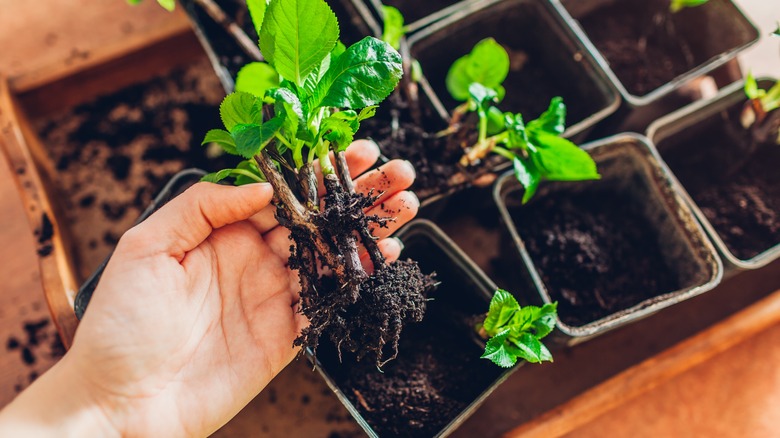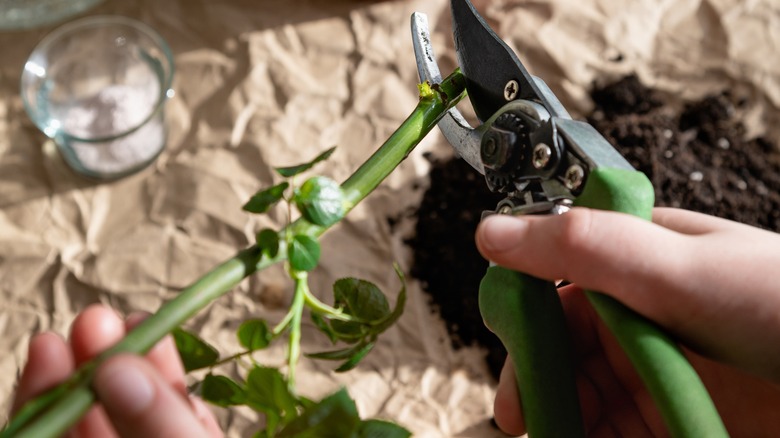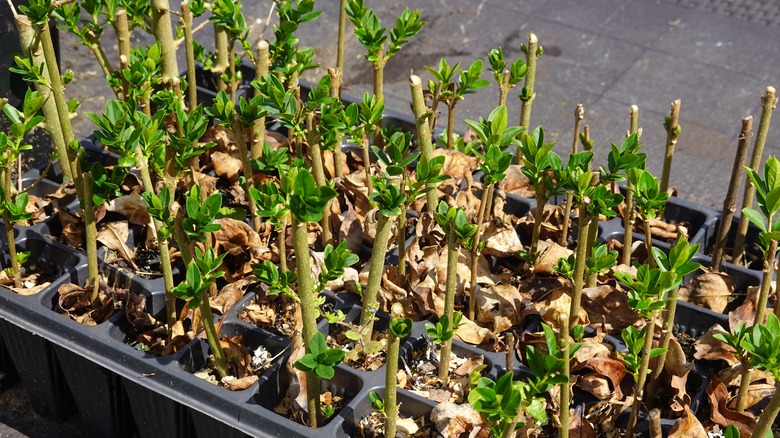Types Of Rooting Hormones You Can Use To Multiply The Plants In Your Garden
We may receive a commission on purchases made from links.
Free plants are a gardener's dream, and one way to obtain them is to propagate the ones you already have. Depending on the plant, it's as simple as splitting up crowded roots, like you would with Russian sage (Perovskia atriplicifolia) or hosta (Hosta plantaginea), two of the 20 perennials you should be dividing in the fall. Yet not all plants are willing to clone themselves so easily. For some, you'll need to take cuttings and wait for roots to develop, a process that can be a nightmare if not done properly. Can you speed things up since it often takes a long time (in some instances, several weeks) before roots form? Yes! Make your dream of free plants a reality with one of the three types of rooting hormones you can use to multiply the plants in your garden.
Rooting hormones are manufactured as powders, gels, or liquids with pros and cons to each. The powder, like RootBoost from Amazon for $8.82, is easy to find and use. But, when planting, be sure that the powder stays on the cutting. Rooting hormone gels cling onto the plant, thereby kickstarting root growth, which make gels, like Clonex, a preference for some gardeners. But keep in mind this option is more costly and has a shorter shelf life. The third type is a concentrated liquid — a popular, easy-to-use brand is Dip 'N Grow. It's effective but requires precise measurements and timed exposure.
Digging into the science of rooting hormones
Novice (and even some not-so-novice) gardeners can be intimidated at the thought of taking cuttings and waiting expectantly for them to sprout and grow. Rooting hormones take some of that angst away by offering benefits, including faster root formation. Rooting hormones are available today as a result of research conducted nearly 100 years ago at the Boyce Thompson Institute (BTI). Seeking ways to encourage faster plant growth, a pair of researchers discovered the compound that became the rooting hormones we still use to this day. Partnering with Merck & Co., what went to market is something that behaves similarly to auxin, a hormone present in plants that is critical to plant growth.
The role of hormones is to boost cell division leading to root development, which can happen with either naturally-occurring hormones or the manufactured ones, but the ones that are lab-generated are sometimes more effective. In addition to hormones, synthetic rooting products will often include other components, like substances that prevent fungal infections. When it comes to root cuttings, some even say you can give them a boost with Pinterest's hydrogen peroxide trick, since the everyday household liquid is known to be anti-fungal.
Shake, smear, or dip to create roots
When it comes to creating new plants from ones you already have, root starters could be the key to your garden's healthy life. The methods vary depending on which type of rooting hormone you choose, but one rule is consistent across all procedures — use just as much rooting hormone as you think you'll need and discard any surplus to avoid contaminating future cuttings in the event any of your current ones are harboring diseases, fungi, or bacteria.
When working with a rooting hormone powder, sprinkle some onto paper or a paper plate (something disposable). Dampen the cutting slightly then dust with powder, shaking off excess. You don't need much, but be careful when placing it in the planting medium so it doesn't brush off. As with a powder, take care when using a gel alternative to minimize potential cross-contamination by utilizing a small paper cup. Follow a similar procedure as with a powder, but there's no need to mist the cutting first. Liquid rooting hormones will need to be reconstituted with water since they're concentrates. Time the exposure to the solution carefully before planting so you don't harm the cuttings by excessive contact with the hormone. For those wanting to garden organically, do homemade substitutes for rooting hormones have any value? According to the University of Hawai'i at Mānoa, an organic alternative made by boiling 2 cups of water with 2 tablespoons of honey and cooling it before dipping the cuttings produced a success rate in the 90th percentile for most plants, which they attributed to antibacterial qualities and sugar in the honey.


